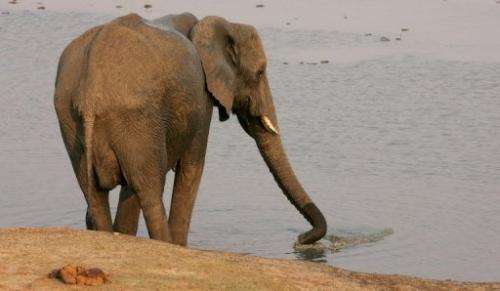Zimbabwe weighs cost of too many elephants

A herd of elephants hobbles past a cluster of acacia trees to a water-hole deep in Zimbabwe's vast Hwange game reserve, attracted by the drone of generators pumping water round the clock into the pool.
With the elephant population ballooning, wildlife authorities have resorted to using 45 generators, each consuming 200 litres (52 gallons) of diesel a week from June to November, to ensure the animals can get water.
The strategy appears to be working. So far this year around 17 elephants have died in the area due to the extreme heat and lack of water, compared to 77 last year.
"The elephants drink close to 90 percent of all the water (pumped) here," said Edwin Makuwe, an ecologist with the Zimbabwe National Parks and Wildlife Authority,
"I think elephants now know that when they hear an engine running, chances are that there is water close by."
But the water, while life-preserving, may be running against the flow of nature.
The 14,600-square-kilometre (5,600-square-mile) reserve is home to between 35,000 to 40,000 elephants, twice its capacity.
The increase in the elephant population has led to higher demand for water at the park, home to over 100 different species of animals including the "Big Five": elephant, lion, leopard, buffalo and the endangered rhinoceros.
Makuwe said the rise in the elephant population at the game reserve, established in 1949, had also led to the destruction of the environment.
"There is so much activity by the elephants that the vegetation has been affected negatively, the trees are no longer growing as fast as they should."
"(The trees) are no longer producing as many seeds as they should. In the long term this will have a negative effect on the entire habitat of Hwange."
He said the quality of the forage had gone down, with elephants stripping tree barks and digging roots for food.
"The African savanna is supposed to be a mosaic of trees and grasses. The moment you start to have more grasslands than trees it is not functioning as African savanna."
Makuwe fears small animals and insects who live in the trees risk extinction.
"If you lose the trees and you are left with the grasslands, then definitely some of the species will be lost," he said.
The authorities are yet to find a solution.
"Some people advocate to let nature take its course ... (but) we are yet to find a method which can convince all the people to accept and bring down the (elephant) population," Makuwe added.
With tourists, who have shunned the country over the years, slowly returning, there is little incentive to cull the main attraction.
In the meantime, Tom Milliken, of the World Wildlife Fund (WWF), said elephants in Hwange were suffering greatly due to the water shortages.
"This is the worst time of the year for elephants and we still have a month before the rains come," he told AFP. "Elephants have most stress this time of the year when there is no water."
(c) 2012 AFP













